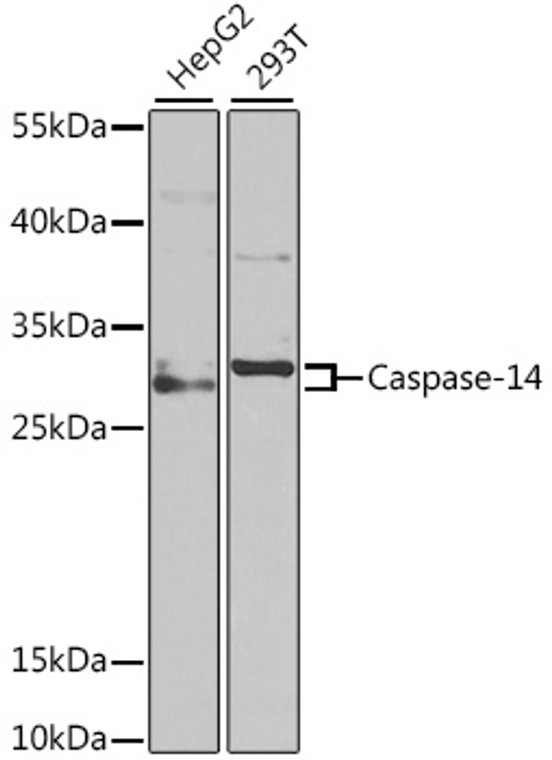| Host: |
Rabbit |
| Applications: |
WB |
| Reactivity: |
Human/Mouse/Rat |
| Note: |
STRICTLY FOR FURTHER SCIENTIFIC RESEARCH USE ONLY (RUO). MUST NOT TO BE USED IN DIAGNOSTIC OR THERAPEUTIC APPLICATIONS. |
| Short Description: |
Rabbit polyclonal antibody anti-Caspase-14 (1-242) is suitable for use in Western Blot research applications. |
| Clonality: |
Polyclonal |
| Conjugation: |
Unconjugated |
| Isotype: |
IgG |
| Formulation: |
PBS with 0.02% Sodium Azide, 50% Glycerol, pH7.3. |
| Purification: |
Affinity purification |
| Dilution Range: |
WB 1:500-1:2000 |
| Storage Instruction: |
Store at-20°C for up to 1 year from the date of receipt, and avoid repeat freeze-thaw cycles. |
| Gene Symbol: |
CASP14 |
| Gene ID: |
23581 |
| Uniprot ID: |
CASPE_HUMAN |
| Immunogen Region: |
1-242 |
| Immunogen: |
Recombinant fusion protein containing a sequence corresponding to amino acids 1-242 of human Caspase-14 (NP_036246.1). |
| Immunogen Sequence: |
MSNPRSLEEEKYDMSGARLA LILCVTKAREGSEEDLDALE HMFRQLRFESTMKRDPTAEQ FQEELEKFQQAIDSREDPVS CAFVVLMAHGREGFLKGEDG EMVKLENLFEALNNKNCQAL RAKPKVYIIQACRGEQRDPG ETVGGDEIVMVIKDSPQTIP TYTDALHVYSTVEGYIAYRH DQKGSCFIQTLVDVFTKRKG HILELLTEVTRRMAEAELVQ EGKARKTNPEIQSTLRKRL |
| Tissue Specificity | Expressed in keratinocytes of adult skin suprabasal layers (from spinous layers to the stratum granulosum and stratum corneum) (at protein level). Expressed in keratinocytes of hair shaft and sebaceous glands (at protein level). In psoriatic skin only expressed at very low levels. The p17/10 mature form is expressed in epidermis stratum corneum, the p20/p8 intermediate form in epidermis upper granular cells of the stratum granulosum. |
| Post Translational Modifications | Maturation by proteolytic processing appears to be a two-step process. The precursor is processed by KLK7 to yield the p20/p8 intermediate form which acts on the precursor to yield the p17/p10 mature form. Initially, cleavage between Ile-152 and Lys-153 has been proposed to yield the large and small subunits of the active enzyme. |
| Function | Non-apoptotic caspase involved in epidermal differentiation. Is the predominant caspase in epidermal stratum corneum. Seems to play a role in keratinocyte differentiation and is required for cornification. Regulates maturation of the epidermis by proteolytically processing filaggrin. In vitro has a preference for the substrate WY-X-X-D motif and is active on the synthetic caspase substrate WEHD-ACF. Involved in processing of prosaposin in the epidermis. May be involved in retinal pigment epithelium cell barrier function. Involved in DNA degradation in differentiated keratinocytes probably by cleaving DFFA/ICAD leading to liberation of DFFB/CAD. |
| Protein Name | Caspase-14Casp-14 Cleaved Into - Caspase-14 Subunit P17 - Mature Form - Caspase-14 Subunit P10 - Mature Form - Caspase-14 Subunit P20 - Intermediate Form - Caspase-14 Subunit P8 - Intermediate Form |
| Database Links | Reactome: R-HSA-6809371 |
| Cellular Localisation | CytoplasmNucleus |
| Alternative Antibody Names | Anti-Caspase-14 antibodyAnti-Casp-14 Cleaved Into - Caspase-14 Subunit P17 - Mature Form - Caspase-14 Subunit P10 - Mature Form - Caspase-14 Subunit P20 - Intermediate Form - Caspase-14 Subunit P8 - Intermediate Form antibodyAnti-CASP14 antibody |
Information sourced from Uniprot.org
12 months for antibodies. 6 months for ELISA Kits. Please see website T&Cs for further guidance







